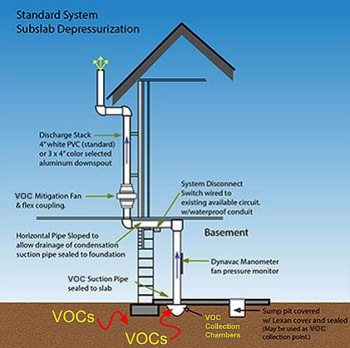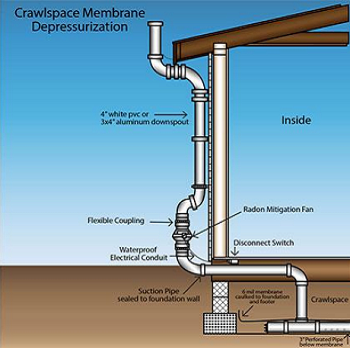Soil Vapor Intrusion Mitigation
South Dakota | Nebraska | Wyoming
Removing Dangerous Soil Gases Through Vapor Intrusion Mitigation Systems
While many gases are found in the soil, they can become problematic for humans when they leach through basements, crawl spaces and foundations and into buildings in a process known as vapor intrusion. Vapor intrusion is defined as the movement of volatile organic compounds (VOCs) from soil or groundwater into indoor air. Some of the most common VOCs include the following:
- Tetrachloroethene (PCE)
- Carbon tetrachloride
- Trichloroethene (TCE)
- Methylene chloride
- Benzene and other gases from petroleum
Whenever these gases are in the soil or groundwater around a building, there is the potential that they will move into the building, build up in the air and cause health problems to those inside. The problem with VOCs is coming increasingly into the public’s eye as many state regulators have begun pointing out high levels in homes and businesses. In addition, building owners are starting to realize the financial and legal implications of failing to monitor and treat high VOC levels.
While radon is certainly a dangerous gas that rises from the soil and into indoor air, it is different from VOCs in that it occurs naturally. Conversely, VOCs are manmade and get into the soil through pollution, industrial spills and similar activities. Buildings located directly over these polluted soils are at high risk for vapor intrusion.
Blackburn Foundation Repair of South Dakota, Nebraska and Wyoming is here to help if you are concerned about vapor intrusion.
Today, the Environmental Protection Agency (EPA) provides guidance in dealing with vapor intrusion through mitigation procedures. Following large amounts of research in soil contamination and VOCs, the EPA recommends using mitigation systems to remove dangerous gases from the soil before they are able to enter the building. Radon mitigation systems are a commonly used option to remove radon gas from the soil beneath homes.
These tactics that address the root problem are seen as far preferable to tactics that only reduce gas levels in indoor air. It is vital that building owners throughout the United States take these recommendations seriously if they want to avoid the effects of health-damaging gases.
Vapor Intrusion Mitigation Options from Blackburn Foundation Repair
Blackburn Foundation Repair in South Dakota, Nebraska and Wyoming is a part of the National Radon Defense network. This gives us access to training and the newest research for treating vapor intrusion concerns. As a National Radon Defense dealer, we can provide our customers with a variety of proven, top-rated mitigation strategies, such as those listed below.
Sub-Slab Depressurization (SSD):
According to the EPA, this mitigation system is among the most popular and is typically seen as preferable in most circumstances. It can be installed both in new as well as existing buildings. SSD works by using a fan-powered ventilation system to remove gases directly from the soil. Therefore, gases are forced to flow away from the house rather than up through any cracks or gaps in the foundation or slab. With this system, gases can no longer seep into indoor air.

Sump Pit Depressurization (SPD):
With this mitigation method, the home’s sump pit is used as the entrance to the soil below the building. Once again, piping and a fan are used to suction unhealthy vapors from the ground and to blow the vapors outside where they are not harmful. This method is a better choice for buildings located in areas with high water tables.
Sub-membrane Depressurization:
This vapor intrusion mitigation system is used in homes that are built over crawl spaces or partial slabs rather than on full slabs. An impermeable membrane is layered across the floor or soil and suction pits are built beneath this membrane. Once again, the vapors are blown out of the soil and into the atmosphere and are no longer allowed to filter into the indoor air.
Many times, our vapor intrusion mitigation experts begin with a pressure field extension test (PFE), which determines how well air can move under the foundation of a building. When required, we use a micromanometer along with small pilot holes in the concrete slab for this test before placing a mitigation system. We also use this test to determine how well the system is working.

Another option for performing routine diagnostics on the soil and mitigation system is vapor pin installation. Metal vapor pins let us easily test soil beneath slabs. When it is not being used, the pin can be completely sealed off to ensure that no harmful gases leak into the indoor air.
Expert Help Through the National Radon Defense Network
The National Radon Defense network works with mitigation experts throughout North America to learn more about how these systems work and how they can best be installed. They use premier methods to seal off slabs, depressurize areas beneath buildings and stop harmful vapors from seeping into indoor air.
Because Blackburn Foundation Repair works with the National Radon Defense network, we have the knowledge and experience that you need to give you peace of mind that the job is being done correctly. You can trust us with any size job and can rest assured that dangerous radon gases and VOCs will no longer be in your indoor air once your vapor mitigation system is successfully installed.
Contact Blackburn Foundation Repair of South Dakota, Nebraska and Wyoming today at 1 (800) 392-3389 to learn more about soil vapor extraction, vapor intrusion mitigation systems and radon testing. We also offer free estimates at no obligation to you.




